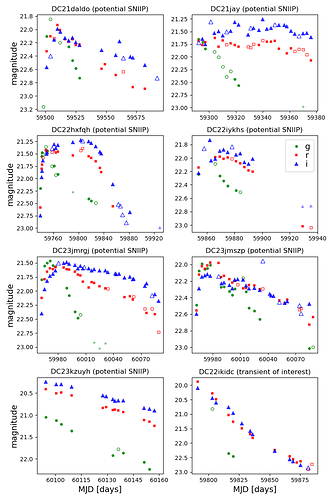Deep drilling in the time domain with DECam II: characterizing the light curves of candidates in the extragalactic fields
Melissa L. Graham, Midori Rollins, Robert A. Knop, Suhail Dhawan, Gloria Fonseca Alvarez, Christopher A. Phillips, Guy Nir, Emily Ramey, and Peter E. Nugent, 2024, MNRAS, submitted
In this second paper on the DECam deep drilling field (DDF) program we release 2,020 optical gri-band difference-image light curves for transients and variables in the COSMOS and ELAIS fields based on data from Feb 2021 through Jul 2023. To demonstrate the wide variety of time domain events detected by the program and encourage others to use the publicly released light curves we preliminarily identify and analyze potential stellar variables, active galactic nuclei, tidal disruption events, supernovae (such as Type Ia, Type IIP, superluminous, and gravitationally lensed supernovae), and fast transients. We also discuss the challenges of analyzing DDF data in the context of the upcoming Vera C. Rubin Observatory and its Legacy Survey of Space and Time, which will include DDFs.
Below we present just two figures from the submitted paper, to demonstrate what the difference-image light curves are like. For a copy of the draft preprint, or access to the publicly released light curves, or if you have any questions, please contact @MelissaGraham or reply in this topic thread.
Figure 1: Below, difference-image DDF light curves for 8 light curves that are potential Type II supernovae based on their duration and peak brightness. Photometric classification was not part of this paper and is left for future work.
Figure 2: Below, difference-image DDF light curves for 4 candidates which met initial cuts to be considered potential fast transients. All except for DC22iylyo (lower right) have non-detections a few days before the first detection which indicate a fast rise. The solid lines represent the photometry of PS1-10bjp from Drout et al. (2014), shifted to approximately match in the r-band.
See also the RRB from 2022:

